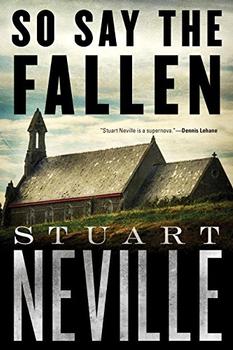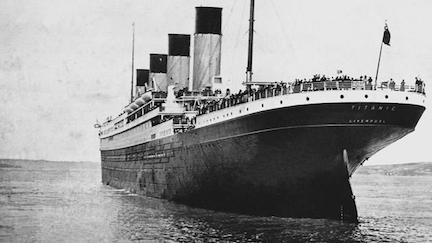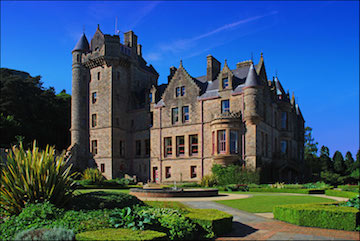Summary | Excerpt | Reviews | Beyond the Book | Read-Alikes | Genres & Themes | Author Bio

Critics' Opinion:
Readers' Opinion:
First Published:
Sep 2016, 336 pages
Paperback:
Jun 2017, 336 pages
 Book Reviewed by:
Book Reviewed by:
Gary Presley
Buy This Book
This article relates to So Say the Fallen
 In So Say the Fallen, it is murder most foul in Belfast. Northern Ireland's capital city is as much a character in Neville's work as it is a place in the novel. It's where the author lives and, has been the home of a number of famous people; it is the birthplace of the Christian author and philosopher C. S. Lewis; John Wood Dunlop invented the pneumatic tire in Belfast, and James Murray invented Milk of Magnesia there. The sixth president of Israel, Chaim Herzog, was born in north Belfast in 1918 (Herzog's father was a rabbi of the Annesley Street Synagogue). And, of course, the Titanic was constructed in Belfast at the Harland and Wolfe Shipyard between 1909 and 1911 - where the same company now maintains the world's largest dry-dock.
In So Say the Fallen, it is murder most foul in Belfast. Northern Ireland's capital city is as much a character in Neville's work as it is a place in the novel. It's where the author lives and, has been the home of a number of famous people; it is the birthplace of the Christian author and philosopher C. S. Lewis; John Wood Dunlop invented the pneumatic tire in Belfast, and James Murray invented Milk of Magnesia there. The sixth president of Israel, Chaim Herzog, was born in north Belfast in 1918 (Herzog's father was a rabbi of the Annesley Street Synagogue). And, of course, the Titanic was constructed in Belfast at the Harland and Wolfe Shipyard between 1909 and 1911 - where the same company now maintains the world's largest dry-dock.
Belfast's recent history has been more troubled, lingering in many people's minds as the site of an ugly territorial dispute that began in the late 1960s, and ending in the late 1990s. "The Troubles" (as they are called) had their roots in centuries of history, back to the 12th century; but the core of the problem started in the 17th century, when English and Scottish settlers heavily colonized Ulster, the northernmost province of Ireland, bringing with them the Protestant religion into a firmly Catholic country.
The city of Belfast was established in that same time period. While there had been a settlement at the location since prehistory, the city we see today was in a large part founded by Sir Arthur Chichester, who had captained a ship against the Spanish Armada and sailed with Sir Francis Drake. By the 19th century Belfast (which derives from the Gaelic beal, meaning rivermouth and feirste, meaning sandbar or ford) had grown to become the industrial powerhouse of Ireland, known for its manufacture of linen and tobacco, heavy engineering and shipbuilding. This industrial strength led to a significantly higher standard of living for those living in Ulster compared to the rural (and predominantly Catholic) southern provinces.
 In the early 20th century, Protestants and Catholics divided into two warring camps over the issue of Irish home rule. Most Irish Catholics wanted complete independence from Britain, but Irish Protestants feared living in a country dominated by a Catholic majority. In an effort to appease the two factions, the UK passed the Government of Ireland Act in 1920 splitting the country into two separate political entities under the control of the United Kingdom. However, this only led to an escalation in guerrilla warfare known as the Irish War of Independence or Anglo-Irish War, fought between the Irish Republican Army (IRA) and British forces. Peace talks in 1921 led to the signing of a treaty the following year that gave Southern Ireland independence. But the treaty also gave Northern Ireland - the entity created by the British in 1920 consisting of six of the nine counties of Ulster - the option to opt out of the Free State (consisting of the other
23 counties), which it did. It was expected that the British government would draw the boundaries of the two entities to put strongly nationalist areas on the independent side of the border and the predominantly unionist populations on the other; however, in a tragic decision intended to make Northern Ireland more viable, the border was drawn to include some strong nationalist areas within Northern
Ireland.
In the early 20th century, Protestants and Catholics divided into two warring camps over the issue of Irish home rule. Most Irish Catholics wanted complete independence from Britain, but Irish Protestants feared living in a country dominated by a Catholic majority. In an effort to appease the two factions, the UK passed the Government of Ireland Act in 1920 splitting the country into two separate political entities under the control of the United Kingdom. However, this only led to an escalation in guerrilla warfare known as the Irish War of Independence or Anglo-Irish War, fought between the Irish Republican Army (IRA) and British forces. Peace talks in 1921 led to the signing of a treaty the following year that gave Southern Ireland independence. But the treaty also gave Northern Ireland - the entity created by the British in 1920 consisting of six of the nine counties of Ulster - the option to opt out of the Free State (consisting of the other
23 counties), which it did. It was expected that the British government would draw the boundaries of the two entities to put strongly nationalist areas on the independent side of the border and the predominantly unionist populations on the other; however, in a tragic decision intended to make Northern Ireland more viable, the border was drawn to include some strong nationalist areas within Northern
Ireland.
By the late 1960s the unrest between the nationalist counties and the remaining counties in Northern Ireland, that had been simmering for the intervening forty years, reached boiling point and exploded into sectarian violence. British troops were deployed in 1969 in an attempt to keep the peace; but between 1970 and 1972 about 500 people were killed; and the British government, faced with a deteriorating situation, took the temporary measure of suspending Northern Ireland's parliament, instigating direct rule from London until talks could take place the following year. These talks failed, as did many other rounds of talks over the intervening decades. It would take about thirty years and 3,600 dead (and many more thousands injured) for a lasting peace treaty to be brokered in 1998, and for the Northern Ireland parliament to resume. The last British troops left in 2007.
 Today, Belfast is both safe and welcoming. It remains the economic center of Northern Ireland and has seen substantial growth in the decades of peace. At 54° north, it isn't exactly a warm place to escape to. The average summer temperature is 65°F, with an average of 157 days of rain a year, and sunny days less than 15% of the time; but the city remains very popular with visitors, offering museums, classic architecture, and traditional Irish hospitality; an inviting gateway to the rest of the Emerald Isle. And of
course, there's always Guinness on tap.
Today, Belfast is both safe and welcoming. It remains the economic center of Northern Ireland and has seen substantial growth in the decades of peace. At 54° north, it isn't exactly a warm place to escape to. The average summer temperature is 65°F, with an average of 157 days of rain a year, and sunny days less than 15% of the time; but the city remains very popular with visitors, offering museums, classic architecture, and traditional Irish hospitality; an inviting gateway to the rest of the Emerald Isle. And of
course, there's always Guinness on tap.
Titanic, courtesy of bbd.co.uk
Civil Rights March in Belfast, 1972, courtesy of belfastchildis.com
Belfast Castle
Filed under Places, Cultures & Identities
![]() This "beyond the book article" relates to So Say the Fallen. It originally ran in October 2016 and has been updated for the
June 2017 paperback edition.
Go to magazine.
This "beyond the book article" relates to So Say the Fallen. It originally ran in October 2016 and has been updated for the
June 2017 paperback edition.
Go to magazine.





The Flower Sisters
by Michelle Collins Anderson
From the new Fannie Flagg of the Ozarks, a richly-woven story of family, forgiveness, and reinvention.

The House on Biscayne Bay
by Chanel Cleeton
As death stalks a gothic mansion in Miami, the lives of two women intertwine as the past and present collide.

The Funeral Cryer by Wenyan Lu
Debut novelist Wenyan Lu brings us this witty yet profound story about one woman's midlife reawakening in contemporary rural China.
Your guide toexceptional books
BookBrowse seeks out and recommends the best in contemporary fiction and nonfiction—books that not only engage and entertain but also deepen our understanding of ourselves and the world around us.